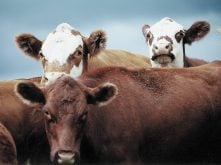This cattle market information is selected from the weekly report from Canfax, a division of the Canadian Cattlemen’s Association. More market information, analysis and statistics are available by becoming a Canfax subscriber by calling 403-275-5110 or at www.canfax.ca.
No spring price rally
The spring price rally for the fed cattle market has been virtually non-existent as fed cattle prices have trended in the low $160s per hundredweight for the better part of this year. Though new annual price highs were established last week, lack of excitement around current cash prices is understandable given feedlots are facing historically large losses.
Last week roughly 40 percent of the cash offerings were fed calves. In general, fed calves are hitting the market 30 days earlier than normal. Competition on the cash market was decent with all three western Canadian packers buying cattle and there were rumblings that U.S. packers were also looking for cattle.
Last week dressed sales were reported at mostly $277 per cwt. delivered. Cattle were being scheduled for late May and early June delivery. Even with a few more calves in the slaughter mix compared to last year, grading continues to impress and remains near the record high. For the week ending April 9, Canadian AAA and Prime grading was reported at 81.7 percent, up from 76.14 percent last year.
In Ontario, dressed sales were reported at mostly $290 per cwt. delivered, fully steady with the previous week. Year to date, 2022 eastern Canadian fed slaughter is down two percent compared to last year.
Fed cattle supplies are expected to remain ample over the next 45 to 60 days, but lower feedlot placements from November to February should see supplies moderate heading into late spring.
In the United States, dressed sales in Iowa and Nebraska were reported from US$223-$231 per cwt. Live sales in Texas and Kansas were at mostly $139 per cwt., $1 stronger. Northern feeding states are trading at a premium over the south and cattle from Kansas are likely going into Nebraska for slaughter.
Over the past four weeks, U.S. beef cow slaughter was 14 percent larger than last year. Dairy cow slaughter over that same time was down three percent. Total U.S. beef exports for February were one percent larger than last year. The top three markets for U.S. beef in February were South Korea, Japan and China.
U.S. cutouts lower
In U.S. beef trade, cut-out values sputtered, with Choice firming modestly US$1 per cwt. higher to average $272.36 and Select dipping almost $2 to average $259.37.
Prices rise for D2 cows
Good demand on both sides of the border rallied non-fed prices higher last week. D2 slaughter cows set a new annual high, averaging $100 per cwt., the strongest weekly average reported since last June. D3 cows broke more than $90 per cwt. to the strongest weekly average since 2017. Dressed cow bids surged around $7 per cwt. higher than the previous week, ranging from $195-$200 per cwt. delivered.
Butcher bull prices eased $1.35 per cwt. lower than the previous week to average $120.11 per cwt. Ground beef value rallied higher, but retail price resistance could limit non-fed price momentum.
Good feeder demand
Alberta feeder prices were steady to stronger last week with good demand on all weights. Lighter calves less than 400 pounds traded unevenly on varied quality and lot size. Good grass demand continued for 400-600 lb. calves, with steers rallying $3-$4 per cwt. higher and heifers firmed $1-$2 per cwt. higher.
Good quality 500-600 lb. steer calves traded in a tight $233-$239 per cwt. range across the Prairies, while Ontario averaged $219.49 per cwt. Big calves heavier than 600 lb. traded near steady last week, while feeders heavier than 800 lb. traded mixed, with steers $1-$2 per cwt. higher and heifers steady to lower. Large feeders heavier than 900 lb. for deferred August delivery traded at a significant premium to spot prices.
Auction volumes eased seasonally lower than the previous week to 19,134 head and were 24 percent larger than the same week last year. Year-to-date auction volumes are up one percent from a year ago, totalling 406,220 head. Feeder exports to the U.S. for the week ending April 2 realigned 17 percent larger than the previous week to 7,445 head. With cheaper cost of gains in the U.S., year-to-date feeder exports continue to trend significantly larger than year ago at 81,997 head.
With limited available feed stocks, interest in grass cattle should intensify as the growing season draws closer.














